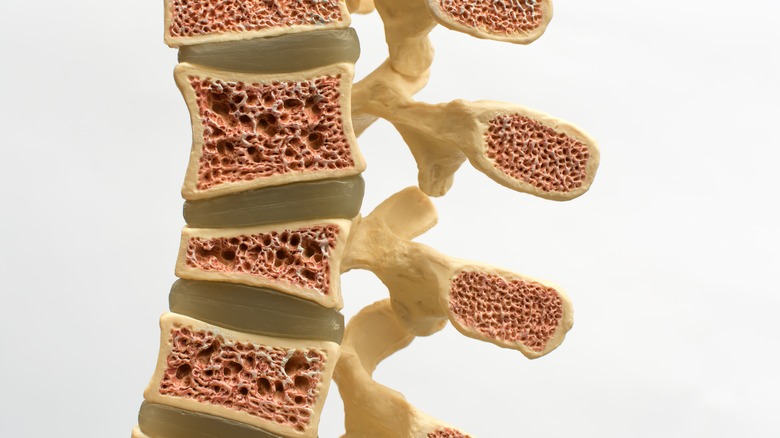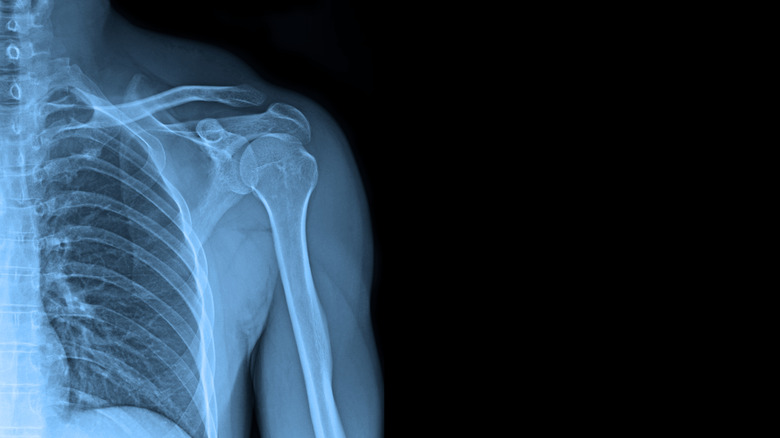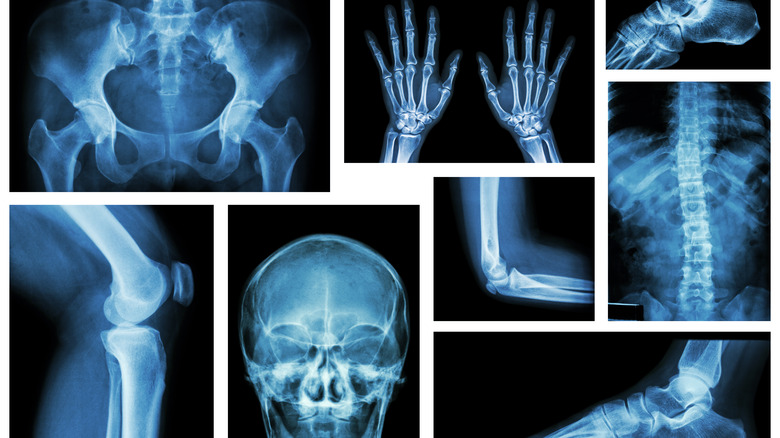What You Should Know About Paget's Disease Of The Bone
Paget's disease is a disease that affects the reformation of the bone material, according to a 2018 study. Healthy bones in the human body go through a process each day called "remodeling". This is where normal stresses on the bone are addressed by bone absorption and reformation, per the American Academy of Orthopedic Surgeons (AAOS).
Paget's disease causes the remodeling process to be abnormal. More specifically, the disease causes the bone absorption rate to be too rapid. The body then attempts to correct this by forming new bone material as rapidly. However, this can result in the bone material being incorrectly produced, forming bones that are too large, misshapen, and often weaker than typical bone material. In many cases, these bones will suffer repeated breaks as a result of the improper bone regrowth process.
Paget's disease can affect various parts of the body. The disease affects roughly 1-2% of the population, according to a 2021 study.
Causes
The causes of Paget's disease are not entirely known, though the disease is still being studied. A 2018 study published in The American Journal of Medicine suggested that the development of the disease was due to an infection in people with a genetic predisposition to the disease, yet no exact link or explanation for the infection was found. Despite a specific or known cause being unidentified, there are a few key risk factors that indicate a higher risk of developing the condition.
The first is age. Paget's disease of the bone has been found primarily in older people. While it is possible for younger individuals to develop the disease, most individuals receiving a diagnosis are at least 40 years old, according to the AAOS.
While there's not a specific gene that can be identified, genetics play a role. As with many illnesses, having a family member diagnosed with Paget's disease of the bone increases the risk of developing the disease. However, having a family member with a diagnosis does not automatically result in the development of the disease, only a higher risk.
Symptoms
Paget's disease is often an asymptomatic disease with at least 20 to 25% of those diagnosed showing no direct symptoms, according to a 2018 study published in the American Journal of Medicine. Patients often live with the disease for some time before diagnosis.
Typically, the most commonly expressed symptom from individuals who have been diagnosed with Paget's disease of the bone is feeling pain in the bones. This pain can be a direct result of the improper bone reformation itself or a byproduct of other complications often associated with Paget's, according to MedlinePlus.
Other symptoms which are often reported in individuals with Paget's disease include headaches, loss of hearing, and pressure on the nerves. Some patients have reported symptoms like fatigue, loss of appetite, and constipation as well, notes the AAOS. In more severe or advanced cases of the disease, a patient may experience increased head size, curvature of the spine, or the bowing of a limb. In 1% of cases, patients may develop a type of bone cancer called Paget's sarcoma, which might involve unrelenting and severe pain.
Diagnosis
In many cases, individuals who receive a diagnosis of Paget's disease were being evaluated and examined for other diseases or illnesses. In fact, an individual undergoing an x-ray will often have evidence of Paget's present in their x-ray results.
When a physician suspects their patient may have Paget's disease, additional tests are performed to confirm the diagnosis. Blood tests to detect and measure serum alkaline phosphatase levels, which are typically elevated in individuals with Paget's, are commonly used, according to the AAOS. Rapid bone turnover can also be detected through urinalysis. A biopsy may also be performed to confirm the presence of Paget's disease and rule out other conditions.
Additional procedures like bone scans can be used to help determine which bones are affected by the disease, according to Stanford Healthcare. This can help physicians decide on the best course of treatment options to provide alleviation of unpleasant symptoms.
Treatment
While there is no cure and any existing damage cannot be reversed, treatment options are available for individuals with Paget's disease to alleviate symptoms and prevent further complications, notes the AAOS. Both surgical and nonsurgical options for disease management are available. It is best to discuss your individual needs with your physician to determine the best course of treatment.
Nonsurgical treatments can include medication, assistive devices, and in some cases, physical therapy. Medications such as nonsteroidal anti-inflammatories (NSAIDs) can be used to help mitigate pain and other minor physical symptoms. When pain is more severe, bisphosphonate medications can be used to help reduce the excessive bone reformation that contributes to the disease progression.
Assistive devices such as canes can help individuals with movement that otherwise would be restricted due to the illness. Physical therapy techniques have been introduced and have shown promising results, according to Medscape.
Surgical treatment options are more invasive but may be required if the disease leads to bone fractures, malalignment or deformity of the bone, or if severe arthritic symptoms are present.
Overview
Bone remodeling is a vital process for a healthy skeleton and is critical to the mobility of all individuals. Paget's disease can be a debilitating illness, causing pain and discomfort in simple daily tasks such as walking or folding laundry. The disease tends to develop later in life.
According to the Mayo Clinic, there are a number of ways to manage symptoms and decrease risks for those living with Paget's disease of the bone. Adjust your home to minimize the risk of falling, and avoid activities, places, or events where there are high risks for falls or stumbles. If you must engage in activities in which falling is a risk, be sure to use proper safety measures and ask for assistance when possible.
Engage in safe and appropriate exercise regularly. A body in motion tends to stay in motion, after all. Consult your doctor about forms of exercise that would be safe for you to perform on a regular basis.
Eat a healthy and nutritious diet that includes sufficient calcium and vitamin D! A well-balanced and nutritious diet plan will provide your body with the nutrients needed for bone health. It can also help you to maintain a healthy weight. Speak with your physician or dietician for specific recommendations on the nutrients you need and whether or not you need any supplements.






